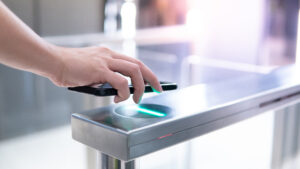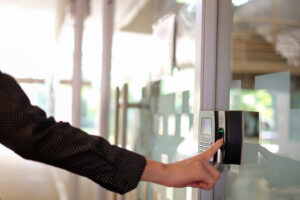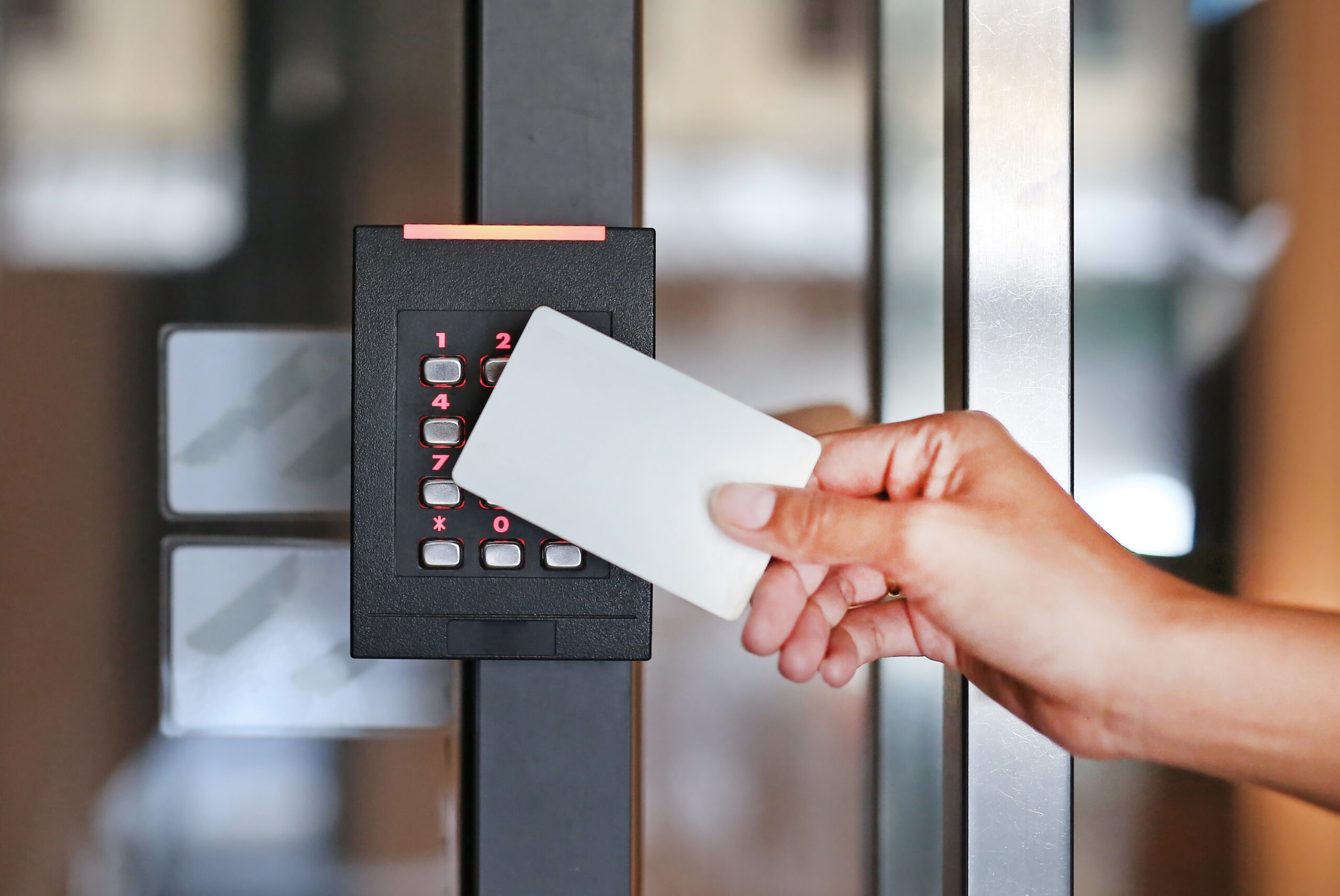In today's increasingly digital and interconnected world, ensuring the security of business premises is more crucial than ever. A door access control system serves as the first line of defense, controlling who can and cannot enter your business. This makes choosing the right system not just a matter of security, but a crucial step in safeguarding your assets, data, and personnel. This introduction to our comprehensive guide will help you understand the essential role of door access control systems for business in security and assist you in selecting the most suitable system for your specific needs.
What is a Door Access Control System?
A door access control system is an electronic system that manages entry to a facility or specific areas within it. It uses credentials, which can be anything from a physical key card to digital information on a mobile device, to verify an individual’s authorization to enter a controlled space. These systems can be standalone or part of an integrated security system that includes video surveillance, alarms, and other security measures.
The Role of Door Access Control Systems in Enhancing Business Security
Door access control systems do more than limit entry to a facility. They offer a range of functionalities that enhance business security:
- Entry Management: Control who enters and exits your facility, ensuring that only authorized individuals can access sensitive areas.
- Integration with Other Systems: When integrated with other security systems, access control can provide comprehensive protection. For instance, linking access control to video surveillance can help verify the identity of individuals entering or exiting, providing a double layer of security.
- Real-Time Monitoring and Alerts: Modern systems can send real-time alerts to security personnel about unauthorized access attempts, allowing for immediate response to potential security breaches.
- Data Collection and Analysis: Access control systems can collect data on entry and exit times, helping to analyze traffic patterns and identify potential security risks.
Types of Access Control Systems
- Discrete Access Control Systems: Ideal for smaller settings or individual areas where simple access control is required without the need for network integration.
- Networked Access Control Systems: Suitable for larger businesses where multiple doors and access points need to be managed centrally. This system type allows for integration across different locations, providing a comprehensive overview and control over the premises.
- Managed Access Control Systems: These are operated by third-party vendors who handle the system maintenance and management, offering businesses a hands-off approach to their access control needs.
- Cloud-Based Access Control Systems: Provide remote management capabilities, scalability, and reduced need for physical infrastructure. These systems are increasingly popular for businesses looking for flexibility and efficiency in their access control solutions.

Advanced Understanding of Door Access Control Systems
Key Components of Access Control Systems
Door access control systems consist of several critical components that work together to secure your facility:
- Access Cards or Credentials: These are issued to users and can range from traditional magnetic stripe cards to smart cards and mobile access credentials.
- Readers: Devices installed at entry points to read credentials. They can include card readers, keypad entry systems, or biometric scanners.
- Control Panels: Hardware that communicates with the readers to authorize entry based on received credentials.
- Electric Lock Hardware: This locks or unlocks doors electronically based on commands from the control panel.
- Management Software: Software used to monitor, manage, and record access activities across the system. It allows administrators to change rules, add or remove users, and review entry logs for security audits.
Advanced Security Features
Modern access control system offer advanced security features that enhance protection:
- Anti-Passback: Prevents users from passing their credentials back to another person to gain unauthorized entry.
- Time-Based Restrictions: Limits access to certain users during specified hours or days.
- Biometric Verification: Adds a layer of security by requiring a fingerprint or facial recognition, ensuring that the person entering is the actual credential holder.
- Integration with Other Systems: Many systems can integrate with CCTV and alarm systems for comprehensive security coverage.
Deeper Dive into Access Control Technologies
- Biometric Systems
Biometric systems provide the highest level of security by using unique physical characteristics such as fingerprints, facial recognition, or iris scans to grant access. They are particularly useful in high-security areas where access needs to be restricted to specific individuals.
- Smart Cards
Smart cards offer a more secure alternative to traditional magnetic stripe cards by incorporating an embedded microchip. These chips can store more data and provide better encryption, making them less susceptible to cloning.
- Mobile Access Systems
With the rise of smartphones, mobile access systems have become increasingly popular. These systems use a smartphone app to grant entry, leveraging technologies such as Bluetooth or NFC. They offer convenience and reduced physical contact, which is particularly advantageous in the current health-conscious environment.
Implementation Strategies for Optimal Security
- Multi-Factor Authentication
For enhanced security, consider implementing multi-factor authentication (MFA) at critical entry points. MFA requires users to provide multiple forms of verification before access is granted, such as a card plus a PIN code or a fingerprint plus a mobile app notification.
- Regular Audits and Updates
To maintain system integrity and protect against emerging threats, regularly audit your access control system. Check for any vulnerabilities and ensure that the firmware and software are up to date.
- Customizable Access Levels
Implementing customizable access levels allows for greater control over who can access different parts of your business. For example, you might allow all employees into the lobby but restrict access to finance or R&D departments.
- Emergency Response Integration
Ensure that your system can be integrated with your business's emergency response plan. This includes having the capability to lock down or open all doors during specific emergencies, such as fires or lockdowns.
Factors to Consider When Choosing a Door Access Control System
- Security Needs
Evaluate the security needs of your business. If you handle sensitive information or valuable goods, investing in a high-security door access system is advisable. For businesses in sectors like banking or healthcare, systems that offer encrypted data and biometric options may be necessary.
- Scalability and Flexibility
Your chosen system should be scalable, capable of adapting as your business grows. Look for systems that allow easy integration with other security systems and can handle an increasing number of users without requiring significant upgrades.
- Ease of Use
The system should be user-friendly, allowing quick and efficient management without specialized training. This includes easy methods for adding or removing users, altering access rights, and reviewing access logs for compliance and auditing purposes.
- Integration Capabilities
Integration with other security systems, such as video surveillance and alarm systems, enhances overall security. Some systems offer remote management capabilities, ideal for businesses operating across multiple locations.
- Cost Considerations
Cost is a major factor in the decision-making process. Include initial setup, maintenance, and potential future upgrade costs in your budgeting. More complex systems, like those using biometric data, may require more upfront investment.
Selecting the right vendor is crucial
- Reputation and Reliability
BCS Consultants are renowned for providing robust access control solutions that integrate the latest technologies with user-friendly interfaces. Their reputation in the market makes them a trustworthy choice.
- Cost Considerations
Understand the total cost of ownership, including installation, maintenance, and any necessary software or hardware upgrades. BCS Consultants offer competitive pricing and transparent cost structures.
- Technical Support and Training
Ensure comprehensive support and training are available. BCS Consultants provide excellent customer service and detailed training materials, ensuring your staff can effectively use the system.
- Warranty and Maintenance
Evaluate the warranty and ongoing maintenance services. Reliable after-sales support is essential for long-term system reliability and performance.
Implementation Considerations
- Installation Process
Discuss the installation process in detail with your vendor to ensure minimal disruption to your business operations. BCS Consultants offer professional installation services with a focus on efficiency and minimizing downtime.
- Training Staff
Ensure your staff are trained on how to use the new system effectively. Proper training reduces the risk of security breaches caused by user error.
- Compliance and Legal Considerations
Confirm that the system complies with local regulations and data protection laws. This is crucial to avoid legal issues and ensure data security.

Conclusion
Invest in the future of your company now with the all-inclusive access control solutions from BCS Consultants. Whether you require a basic system or a full-featured integrated security system, BCS Consultants has the knowledge and tools to properly protect your people and property.
BCS Consultants supports companies of all sizes with a variety of cloud- and on-premise access control solutions. Our door access control systems for business are designed to provide companies with the flexibility, wide integration options, and strong support they need to continue running safe and effective operations.
For further information on our security solutions, call +1 949-333-1000 or visit our website.
FAQs
Q1: What are the different types of door access control systems available for businesses?
A: Businesses can choose from various types of door access control systems, including discrete systems for smaller facilities, networked systems for larger organizations, managed systems for outsourced management, and cloud-based systems for flexible and scalable security solutions.
Q2: How do I know which door access control system is right for my business in California?
A: Consider factors such as the size and scale of your business, specific security requirements, and your current technological infrastructure. It's also crucial to evaluate the system's ability to integrate with existing software, its scalability, and the types of authentication methods it supports. Consulting with a security expert can provide tailored advice for your needs.
Q3: What should I look for in a vendor when choosing a door access control system?
A: Look for vendors with a strong reputation and proven reliability in the field of access control. Assess the total cost of ownership, including installation and maintenance. Ensure they offer comprehensive technical support and training, and check for favorable warranty terms. Vendor reviews and customer testimonials can also provide insights into their service quality.


You must be logged in to post a comment.